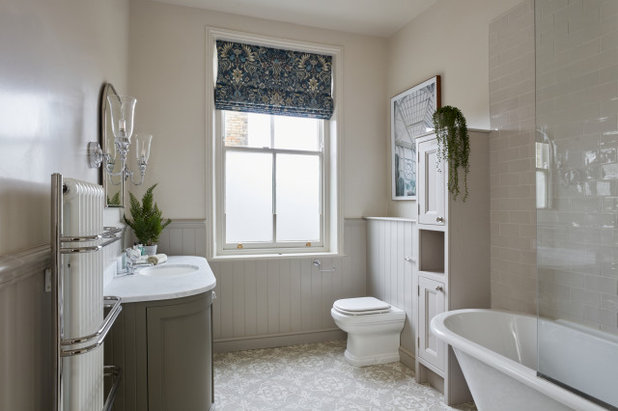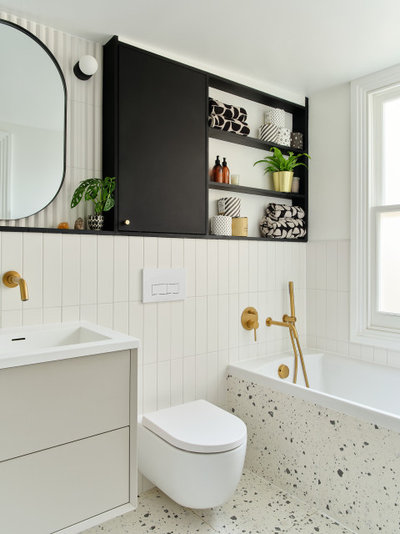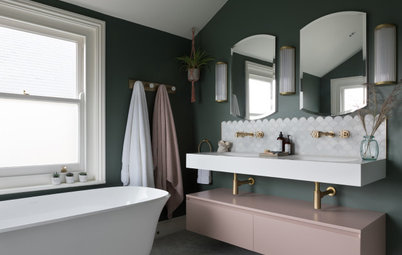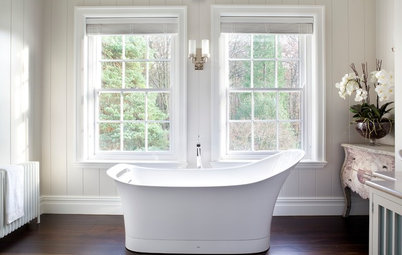How to Cut the Cost of Your Bathroom Renovation
Costs can easily escalate with bathroom projects, so follow this expert advice on how to budget wisely
Cheryl F
10 February 2019
Houzz Contributor. I'm a London-based journalist with years of experience writing for the UK's top interiors titles. I love shopping for quirky accessories, have a passion for rummaging through vintage stores and I'm ever-hopeful of finding that elusive perfect paint shade.
Houzz Contributor. I'm a London-based journalist with years of experience writing... More
You don’t have to fritter away a fortune on a new bathroom – as part of our Bathroom Planning guide, our experts reveal their shortcuts and insider tips for a beautiful bathing space. Solid-gold taps, walk-in rain shower and Jacuzzi not required…
Expert advice from: Raj Ghaly of Bathrooms By Design; Justin Wedgbury at Omega Developments; Steve Baker at The London Bath Co
Starting your bathroom project? Read How to Plan for a Bathroom Renovation
Expert advice from: Raj Ghaly of Bathrooms By Design; Justin Wedgbury at Omega Developments; Steve Baker at The London Bath Co
Starting your bathroom project? Read How to Plan for a Bathroom Renovation
1. Plan a sensible layout
If you want to avoid expensive mistakes, this is rule number one.
“Ask your fitter for suggestions and opinions as to what might work before you get your heart set on a layout, product or idea that can’t be realised (either at all, or within a sensible budget),” Justin Wedgbury says.
“I’ve been to houses where people have bought shower enclosures that totally dominate a room and leave tiny spaces to side-step around, or devised a layout that means the door hits the basin when opened,” he says.
“When visiting a showroom, take pictures of your space as well as the measurements,” he adds. “The bathroom isn’t always an easy or straightforward room to buy for.”
More: Key Dimensions to Know for the Perfect Bathroom Layout
If you want to avoid expensive mistakes, this is rule number one.
“Ask your fitter for suggestions and opinions as to what might work before you get your heart set on a layout, product or idea that can’t be realised (either at all, or within a sensible budget),” Justin Wedgbury says.
“I’ve been to houses where people have bought shower enclosures that totally dominate a room and leave tiny spaces to side-step around, or devised a layout that means the door hits the basin when opened,” he says.
“When visiting a showroom, take pictures of your space as well as the measurements,” he adds. “The bathroom isn’t always an easy or straightforward room to buy for.”
More: Key Dimensions to Know for the Perfect Bathroom Layout
2. Use existing plumbing
Related to rule number one, rearranging pipework can be pricey – and unnecessary.
“Changing the layout of the room entirely, or even marginally, to accommodate plumbing in different areas of the room could significantly raise the cost of a renovation, especially when considering installation costs,” Raj Ghaly says. “So it’s recommended you try to use existing plumbing and not drastically change the layout of your room.”
Related to rule number one, rearranging pipework can be pricey – and unnecessary.
“Changing the layout of the room entirely, or even marginally, to accommodate plumbing in different areas of the room could significantly raise the cost of a renovation, especially when considering installation costs,” Raj Ghaly says. “So it’s recommended you try to use existing plumbing and not drastically change the layout of your room.”
3. Seek professional advice
If you’re on a budget, it can be tempting to go it alone. But planning everything yourself can be a false economy.
“Right in the early stages, get professional bathroom fitters in to take a look. They usually offer free advice, so pick their brains,” Justin advises.
“If you find a good fitting company, they can assist in the buying of materials and furniture. This should mean a substantial financial saving and be less problematic all round,” he says. “This doesn’t mean you just ‘get what you’re given’ – the decisions are always yours, it’s your bathroom.”
Bear in mind professional bathroom companies often get the best deals. “It’s in the interest of suppliers, including prestigious showrooms, online distributors and high street outlets, to nurture relationships with bulk-buyers,” Justin says. “Discounts, favours and offers all help to provide the end customer with plenty of options.”
Read reviews of bathroom designers and fitters in your area.
If you’re on a budget, it can be tempting to go it alone. But planning everything yourself can be a false economy.
“Right in the early stages, get professional bathroom fitters in to take a look. They usually offer free advice, so pick their brains,” Justin advises.
“If you find a good fitting company, they can assist in the buying of materials and furniture. This should mean a substantial financial saving and be less problematic all round,” he says. “This doesn’t mean you just ‘get what you’re given’ – the decisions are always yours, it’s your bathroom.”
Bear in mind professional bathroom companies often get the best deals. “It’s in the interest of suppliers, including prestigious showrooms, online distributors and high street outlets, to nurture relationships with bulk-buyers,” Justin says. “Discounts, favours and offers all help to provide the end customer with plenty of options.”
Read reviews of bathroom designers and fitters in your area.
4. Give a good brief
Avoid a long list of niggly jobs at the end of your project – which will cost extra money to fix – by drawing up a clear contract with your fitter at the start. Know where you stand, so you can budget accordingly.
“Make sure it’s written down by the company or by you and agreed which tasks will be done,” Justin says. “Many fitters won’t include ‘making good’ door frames, decoration and electrical works, for example.”
Avoid a long list of niggly jobs at the end of your project – which will cost extra money to fix – by drawing up a clear contract with your fitter at the start. Know where you stand, so you can budget accordingly.
“Make sure it’s written down by the company or by you and agreed which tasks will be done,” Justin says. “Many fitters won’t include ‘making good’ door frames, decoration and electrical works, for example.”
5. Tile with restraint
Unless you’re planning a wetroom, you don’t need to cover every inch with porcelain, Raj advises. Not only is this cheaper – both in terms of labour and costs – but part-tiling is also often more practical.
“The advantage of part-tiling is that the bathroom becomes much more flexible,” Raj says. “For example, you can paint the rest of the walls, which means the bathroom can be redesigned more easily in the future, using different colours.
“Hanging pictures on bathroom walls is also becoming popular and part-tiling gives you this option,” he adds.
When it comes to tile prices, Raj says, “Ceramic tiles are generally cheaper. Imitation tiles (marble-look for example) can be inexpensive, yet will give your bathroom a similar luxury look and feel like the real thing.”
Unless you’re planning a wetroom, you don’t need to cover every inch with porcelain, Raj advises. Not only is this cheaper – both in terms of labour and costs – but part-tiling is also often more practical.
“The advantage of part-tiling is that the bathroom becomes much more flexible,” Raj says. “For example, you can paint the rest of the walls, which means the bathroom can be redesigned more easily in the future, using different colours.
“Hanging pictures on bathroom walls is also becoming popular and part-tiling gives you this option,” he adds.
When it comes to tile prices, Raj says, “Ceramic tiles are generally cheaper. Imitation tiles (marble-look for example) can be inexpensive, yet will give your bathroom a similar luxury look and feel like the real thing.”
- 6. Know your materials
Still on the subject of tiles, remember you don’t have to choose the most expensive options – especially these days.
- “Use good-quality porcelain tiles instead of natural stone,” Steve Baker advises. “Technology is so good now, it’s often hard to distinguish between them, and porcelain tiles can be considerably cheaper.
- “Porcelain is also much more durable than natural stone and less prone to cracking and chipping, and it doesn’t require regular sealing to stop it staining,” Steve adds. “Go for a full-bodied porcelain tile, which means your tiler will be able to polish the edges instead of using unsightly trims.”
7. Avoid too many tradespeople
“Bathrooms aren’t cheap. After kitchens, they’re the most expensive room in the house to overhaul,” Justin says. “There’s a lot of labour involved from different trades: plumbing, carpentry, electrical, tiling, decoration.
“It can be confusing to pin down exact costs in the early stages,” he says, “so it can be better to use a trusted company that does the lot, as they’ll help ensure different tradespeople don’t ‘tread on each other’s toes’.”
“Bathrooms aren’t cheap. After kitchens, they’re the most expensive room in the house to overhaul,” Justin says. “There’s a lot of labour involved from different trades: plumbing, carpentry, electrical, tiling, decoration.
“It can be confusing to pin down exact costs in the early stages,” he says, “so it can be better to use a trusted company that does the lot, as they’ll help ensure different tradespeople don’t ‘tread on each other’s toes’.”
8. Ditch the bath
This isn’t for everyone, but if you aren’t one of life’s long soakers, it could be a money-saving option.
“We’ve noticed more customers opting for showers rather than baths, and this can not only bring down the initial fitting outlay, but lower running costs long-term due to greater energy efficiency,” Raj says.
More: How to Choose a Shower
This isn’t for everyone, but if you aren’t one of life’s long soakers, it could be a money-saving option.
“We’ve noticed more customers opting for showers rather than baths, and this can not only bring down the initial fitting outlay, but lower running costs long-term due to greater energy efficiency,” Raj says.
More: How to Choose a Shower
9. Choose ex-display
Buying former showroom fittings can be a great way to bag a bargain.
“These shouldn’t have negative connotations,” Raj says. “You’ll reduce your expenditure by purchasing a product that’s been on display in a showroom but is unlikely to be damaged.”
Call around local showrooms to find out what might be available in-store. You may find a stylish basin in one shop and a great bath in another.
“Clearance items will also save you a lot,” Raj adds. “These may include discontinued items, so it’s stock that bathroom retailers need to get rid of and will offer at a reduced price.
“Comparing prices is also advised, but avoid the temptation to compromise,” he warns. “By going for the cheapest deals, you may be sacrificing on the quality of design and service.”
Steve adds, “Also look at the entry-level ranges by quality bathroom manufacturers, as you’ll often get better materials for less money.”
Buying former showroom fittings can be a great way to bag a bargain.
“These shouldn’t have negative connotations,” Raj says. “You’ll reduce your expenditure by purchasing a product that’s been on display in a showroom but is unlikely to be damaged.”
Call around local showrooms to find out what might be available in-store. You may find a stylish basin in one shop and a great bath in another.
“Clearance items will also save you a lot,” Raj adds. “These may include discontinued items, so it’s stock that bathroom retailers need to get rid of and will offer at a reduced price.
“Comparing prices is also advised, but avoid the temptation to compromise,” he warns. “By going for the cheapest deals, you may be sacrificing on the quality of design and service.”
Steve adds, “Also look at the entry-level ranges by quality bathroom manufacturers, as you’ll often get better materials for less money.”
- 10. Save where appropriate
Recycle the decent things, by all means, but not every last screw or bath plug, or you’re defeating the object of planning a lovely new bathroom.
“Keeping the old ceiling because it’s ‘OK’, or not having an extractor fan fitted as it costs a bit more, could affect the finished look,” Justin says.
“Saving old taps or radiators to put in the new suite won’t help your budget much when the fitter is having to clean them up or strip them down carefully to remove anyway,” he says.
Raj adds, “Opting for a cheap toilet can lead to problems in the future, due to poor build quality and because flushing performance could be less than optimal. Fixtures such as basins are also worth investing in, as these are products you’ll want to stand the test of time without cracking or staining.”
11. Be light savvy, too
Lights can get forgotten in bathrooms, but they make a big difference to the final effect. “Use good-quality LED spotlights for your bathroom,” Steve suggests. “They may cost a little more initially, but you’ll make savings sooner than you think and you won’t have the inconvenience of constantly changing light bulbs.”
More: Expert Tips for Planning Your Bathroom Lighting
Tell us…
Have you managed to save money on a bathroom project? Share your tips in the Comments.
Lights can get forgotten in bathrooms, but they make a big difference to the final effect. “Use good-quality LED spotlights for your bathroom,” Steve suggests. “They may cost a little more initially, but you’ll make savings sooner than you think and you won’t have the inconvenience of constantly changing light bulbs.”
More: Expert Tips for Planning Your Bathroom Lighting
Tell us…
Have you managed to save money on a bathroom project? Share your tips in the Comments.
Related Stories
Bathrooms
How to Plan for a Bathroom Renovation
Wondering where to start when renovating your bathroom? Ask yourself these questions to ensure you plan well
Full Story
Bathrooms
Key Dimensions to Know for the Perfect Bathroom Layout
By Eva Byrne
Bookmark this valuable guide to choosing the right-sized sanitaryware for your washspace
Full Story
Bathrooms
8 Questions to Ask Before Starting a Bathroom Renovation
Revamping your wash space? Get a clear idea of what you want to achieve by thinking about these essentials first
Full Story
Bathrooms
How to Design a Bathroom That’s Easy to Clean
Want a clutter-free, sparkling bathroom? Follow this expert advice on how to cut down on cleaning time
Full Story
Bathrooms
How Easy Would It Be to Change My Bathroom Layout?
By Cheryl F
Looking to rejig your washroom? Consider this expert advice before you start rearranging any plumbing
Full Story
Bathrooms
How Should I Heat My Bathroom?
Keep your bathroom cosy with a heat source that will suit you and your space
Full Story
Bathrooms
How Long Does a Bathroom Renovation Take?
By Kate Burt
A week, two – a month? Three experts break down bathroom renovation timelines
Full Story
Bathrooms
Which Flooring Should I Choose for My Bathroom?
Expert advice to help you decide on the best flooring for your bathroom
Full Story
Bathrooms
What Happens When you Hire a Bathroom Designer?
By Jo Simmons
Thinking of employing a professional to help you design your bathroom? Find out more about what they can offer
Full Story
Bathrooms
How to Choose the Perfect Shower Head
By Kate Burt
In the midst of a bathroom renovation, a shower head may seem a small detail, but it’s a well-used one, so get it right
Full Story













































I totally agree with everyone who says quality of fittings is so important. We’ve recently moved to a house built 25 years ago. All the bathrooms are still as they were when the house was built, but because top quality fittings & tiles were used they all look incredibly good for the age!! The only thing changed over the years has been the flooring. We are planning on upgrading each as & when we have the cash, when we do it will be with quality products from the UK where possible.
We’ve remodeled the master bath in several previous homes. Glass shower enclosures always look great and feel luxurious, and it’s well worth the money to invest in the “stay-clear” glass. It’s amazing, albeit somewhat expensive.
I remodeled a bathroom last month and saved around $3,000 by constructing the shower to fit a ready made glass enclosure. We added about 6 inches to the shower space and bought a high quality 48x48 inch frameless glass enclosure that was identical to custom made. It even came with a finish on it that cleans easier and the custom guys charge a small fortune for that, too. Overall, by hiring someone who was good and affordable, buying quality porcelain tile on clearance and shopping very carefully, I think I saved around $20K than my first quote and I am very pleased, it's gorgeous!